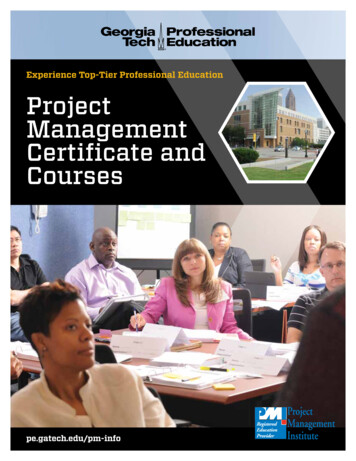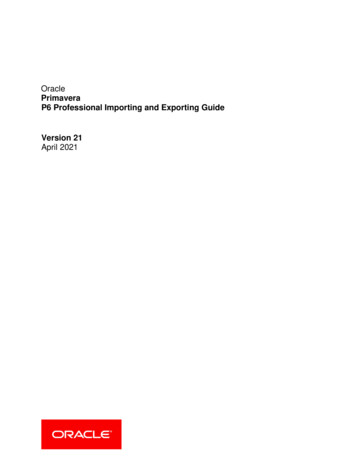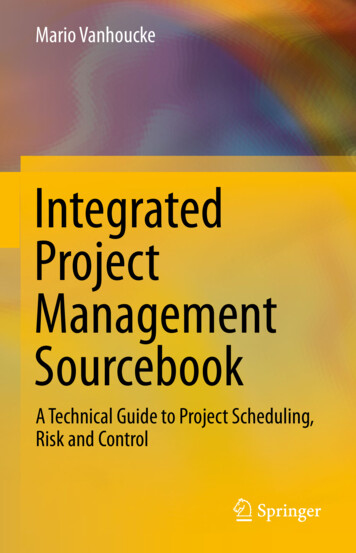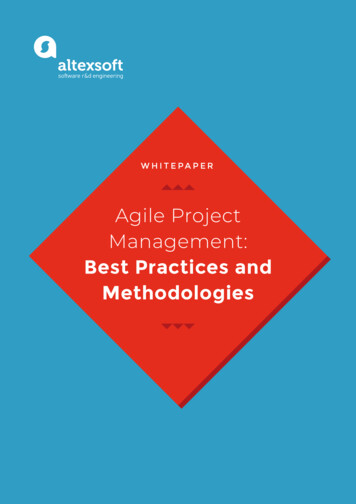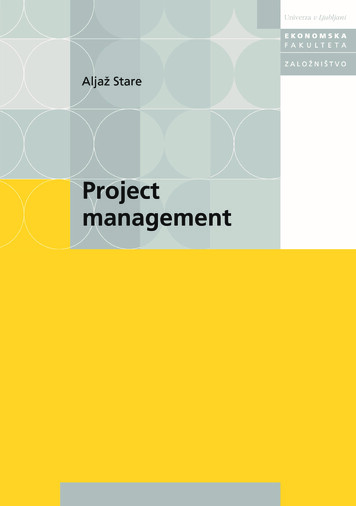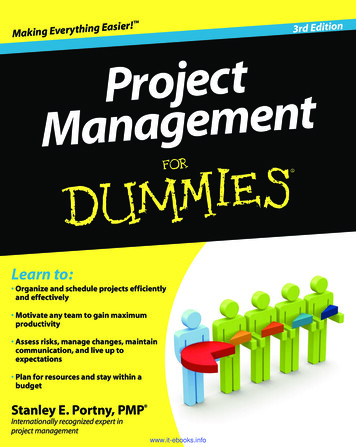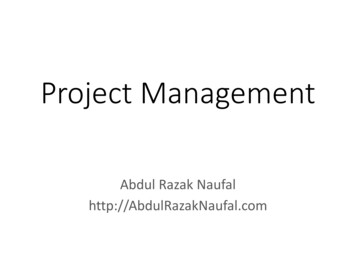
Transcription
Project ManagementAbdul Razak Naufalhttp://AbdulRazakNaufal.com
Textbooks2
Course Outline1. Introduction to Project Management2. The Project Management and Information Technology Context3. The Project Management Process Groups: A Case Study4. Project Integration Management5. Project Scope Management6. Project Time Management7. Project Cost Management8. Project Quality Management9. Project Human Resource Management10. Project Communication Management11. Project Risk Management12. Project Procurement Management3
1. Introduction to ProjectManagement4
Learning Objectives Understand the growing need for better project management,especially for information technology projects Explain what a project is, provide examples of projects, attributesof projects, and describe the triple constraint of projects Describe key elements of the project management, includingproject stakeholders, the knowledge areas, tools and techniques Discuss the relationship between project, program, and portfoliomanagement and the contributions to enterprise success Understand the role of the project manager by describing whatproject managers do, what skills they need, and what the careerfield is like Describe the project management profession, including the roleof organizations like the Project Management Institute (PMI) andthe importance of certification and ethics5
Introduction Many organizations today have a new or renewedinterest in project management Computer hardware, software, networks, and theuse of interdisciplinary and global work teams haveradically changed the work environment The world as a whole spends nearly 10 trillion ofits 40.7 trillion gross product on projects of allkinds More than 16 million people regard projectmanagement as their profession6
Project Management Statistics The overall information and communicationstechnology (ICT) market grew by 6 percent to almost 3trillion in 2010 In the U.S. the size of the IT workforce topped 4 millionworkers for the first time in 2008 In 2007 the total compensation for the average seniorproject manager in U.S. dollars was 104,776 per yearin the United States, 111,412 in Australia, and 120,364 in the United Kingdom The number of people earning their ProjectManagement Professional (PMP) certification continuesto increase7
Motivation for Studying InformationTechnology (IT) Project Management IT Projects have a terrible track record, as describedin the What Went Wrong? A 1995 Standish Group study (CHAOS) found thatonly 16.2% of IT projects were successful inmeeting scope, time, and cost goals; over 31% of ITprojects were canceled before completion A PricewaterhouseCoopers study found thatoverall, half of all projects fail and only 2.5% ofcorporations consistently meet their targets forscope, time, and cost goals for all types of project8
Advantages of Using FormalProject Management Better control of financial, physical, and humanresources Improved customer relations Shorter development times Lower costs Higher quality and increased reliability Higher profit margins Improved productivity Better internal coordination Higher worker morale9
What Is a Project? A project is “a temporary endeavor undertaken tocreate a unique product, service, or result”(PMBOK Guide, Fourth Edition, 2008, p. 5) On the other hand, operations is work done tosustain the business Projects end when their objectives have beenreached or the project has been terminated Projects can be large or small and take a short orlong time to complete10
Examples of IT Projects A technician replaces ten laptops for a smalldepartment A small software development team adds a newfeature to an internal software application for thefinance department A college campus upgrades its technologyinfrastructure to provide wireless Internet access acrossthe whole campus A cross-functional task force in a company decideswhat Voice-over-Internet-Protocol (VoIP) system topurchase and how it will be implemented A government group develops a system to track childimmunizations11
Top Strategic Technologies for 2008(Gartner)1.2.3.4.5.Green ITUnified communicationsBusiness process modelingVirtualization 2.0Social software12
Top Strategic Technologies for 2012(Gartner)1. Media tablets and beyond: no single platform willdominate the market, but that tablet sales will soonsurpass laptop sales2. Mobile-centric applications and interfaces: Userinterfaces will be mobile-centric, emphasizing touch,gesture, search, voice, and video3. Contextual and social user experience: A contextuallyaware interface anticipates a user’s needs and providesthe most appropriate content, product, or service4. Internet of things: Internet usage will expand as sensorsare added to physical items, ex: NFC allows users to makepayments, board airplanes, etc5. Cloud computing: Enterprises will move from trying tounderstand the cloud to making decisions on when toimplement cloud services13
Media Snapshot: Where IT Matters In 2006, Baseline Magazine published “Where I.T.Matters: How 10 Technologies Transformed 10Industries” as a retort to Nicholas Carr’s ideas(author of “IT Doesn’t Matter”) VoIP has transformed the telecommunications industryand broadband Internet access Global Positioning Systems (GPS) has changed thefarming industry Digital supply chain has changed the entertainmentindustry’s distribution system14
Project Attributes A project:Has a unique purposeIs temporaryIs developed using progressive elaborationRequires resources, often from various areasShould have a primary customer or sponsorThe project sponsor usually provides the direction andfunding for the project Involves uncertainty 15
Discussion Ceritakan tentang salah satu project yang pernahanda tangani Mengapa pekerjaan itu anda sebut sebuah project? Apa bedanya pekerjaan biasa dengan project?16
Project and Program Managers Project managers work with project sponsors, theproject team, and other people involved in aproject to meet project goals Program: group of related projects managed in acoordinated way to obtain benefits and control notavailable from managing them individually(PMBOK Guide, Fourth Edition, 2008, p. 9) Program managers oversee programs; often act asbosses for project managers17
Triple Constraint of ProjectManagementSuccessful projectmanagement meansmeeting all three goals(scope, time, and cost)– and satisfying theproject’s sponsor!18
Discussion Ceritakan salah satu project yang pernah andatangani dan ternyata dinyatakan bahwa project itugagal Mengapa project tersebut dikatakan gagal?19
What is Project Management? Project management is “the application ofknowledge, skills, tools and techniques to projectactivities to meet project requirements”(PMBOK Guide, Fourth Edition, 2008, p. 6) Project managers strive to meet the tripleconstraint by balancing project scope, time, andcost goals20
Project Management Framework21
Project Stakeholders Stakeholders are the people involved in or affectedby project activities Stakeholders include: The project sponsorThe project managerThe project teamSupport staffCustomersUsersSuppliersOpponents to the project22
9 Project Management KnowledgeAreas Knowledge areas describe the key competenciesthat project managers must develop 4 core knowledge areas lead to specific projectobjectives (scope, time, cost, and quality) 4 facilitating knowledge areas are the means throughwhich the project objectives are achieved (humanresources, communication, risk, and procurementmanagement) 1 knowledge area (project integration management)affects and is affected by all of the other knowledgeareas All knowledge areas are important!23
Project Management Tools andTechniques Project management tools and techniques assistproject managers and their teams in variousaspects of project management Some specific ones include: Project charter, scope statement, and WBS (scope) Gantt charts, network diagrams, critical path analysis,critical chain scheduling (time) Cost estimates and earned value management (cost) See Table on the next slide for many more24
25
Super Tools “Super tools” are those tools that have high use andhigh potential for improving project success, such as: Software for task scheduling (such as project managementsoftware) Scope statements Requirements analyses Lessons-learned reports Tools already extensively used that have been found toimprove project importance include: Progress reportsKick-off meetingsGantt chartsChange requests26
What Went Right? Improved ProjectPerformance The Standish Group’s CHAOS studies showimprovements in IT projects in the past decade: The number of successful IT projects has more thandoubled, from 16 percent in 1994 to 35 percent in 2006 The number of failed projects decreased from 31percent in 1994 to 19 percent in 2006 The United States spent more money on IT projects in2006 than 1994 ( 346 billion and 250 billion,respectively), but the amount of money wasted onchallenged and failed projects was down to 53 billion in2006 compared to 140 billion in 199427
Why the Improvements?"The reasons for the increase in successful projectsvary. First, the average cost of a project has beenmore than cut in half. Better tools have been createdto monitor and control progress and better skilledproject managers with better management processesare being used. The fact that there are processes issignificant in itself.”Standish Group, "CHAOS 2001: A Recipe for Success" (2001)28
Project Success There are several ways to define project success: The project met scope, time, and cost goals The project satisfied the customer/sponsor The results of the project met its main objective, such asmaking or saving a certain amount of money, providing agood return on investment, or simply making thesponsors happy29
What Helps Projects Succeed?1. Executive support2. User involvement3. Experienced projectmanager4. Clear businessobjectives5. Minimized scope6. Standard softwareinfrastructure7. Firm basicrequirements8. Formal methodology9. Reliable estimates10.Other criteria, such assmall milestones,proper planning,competent staff, andownershipThe Standish Group, “Extreme CHAOS,” (2001)30
What the Winners Do Recent research findings show that companies thatexcel in project delivery capability: Use an integrated project management toolbox (usestandard/advanced PM tools, lots of templates) Grow project leaders, emphasizing business and softskills Develop a streamlined project delivery process Measure project health using metrics, like customersatisfaction or return on investment31
Discussion Mengapa kita perlu memahami projectmanagement? Bagaimana cara termudah untuk memahamitentang project management?32
Program and Project PortfolioManagement A program is “a group of related projects managedin a coordinated way to obtain benefits and controlnot available from managing them individually”(PMBOK Guide, Fourth Edition, 2008, p. 9) A program manager provides leadership anddirection for the project managers heading theprojects within the program Examples of common programs in the IT fieldinclude infrastructure, applications development,and user support33
Project Portfolio Management As part of project portfolio management,organizations group and manage projects andprograms as a portfolio of investments thatcontribute to the entire enterprise’s success Portfolio managers help their organizations makewise investment decisions by helping to select andanalyze projects from a strategic perspective34
Project Management Compared toProject Portfolio Management35
Best Practice A best practice is “an optimal way recognized byindustry to achieve a stated goal or objective”* Robert Butrick suggests that organizations need tofollow basic principles of project management,including these two mentioned earlier: Make sure your projects are driven by your strategy; beable to demonstrate how each project you undertakefits your business strategy, and screen out unwantedprojects as soon as possible Engage your stakeholders; ignoring stakeholders oftenleads to project failure; be sure to engage stakeholdersat all stages of a project, and encourage teamwork andcommitment at all times*Project Management Institute, Organizational Project Management Maturity Model(OPM3) Knowledge Foundation (2003), p. 13.36
Sample Project Portfolio Approach37
Sample Project PortfolioManagement: Project Health38
Discussion Apakah yang dimaksud dengan program? Jelaskan perbedaan project managementdan project portfolio management39
The Role of the Project Manager Job descriptions vary, but most includeresponsibilities like planning, scheduling,coordinating, and working with people to achieveproject goals Remember that 97% of successful projects were ledby experienced project managers, who can oftenhelp influence success factors40
Suggested Skills for Project Managers Project managers need a wide variety of skills They should: Be comfortable with change Understand the organizations they work in and with Be able to lead teams to accomplish project goals41
Suggested Skills for Project Managers The Project Management Body of Knowledge Application area knowledge, standards, andregulations Project environment knowledge General management knowledge and skills Soft skills or human relations skills42
Ten Most Important Skills andCompetencies for Project Managers1. People skills2. Leadership3. Listening4. Integrity, ethical behavior, consistent5. Strong at building trust6. Verbal communication7. Strong at building teams8. Conflict resolution, conflict management9. Critical thinking, problem solving10.Understands, balances priorities43
Different Skills Needed in DifferentSituations Large projects: leadership, relevant priorexperience, planning, people skills, verbalcommunication, and team-building skills were mostimportant High uncertainty projects: risk management,expectation management, leadership, people skills,and planning skills were most important Very novel projects: leadership, people skills,having vision and goals, self confidence,expectations management, and listening skills weremost important44
Importance of Leadership Skills Effective project managers provide leadership byexample A leader focuses on long-term goals and big-pictureobjectives while inspiring people to reach thosegoals A manager deals with the day-to-day details ofmeeting specific goals Project managers often take on the role of bothleader and manager45
Careers for IT Project Managers In a 2006 survey by CIO.com, IT executives rankedthe skills that would be the most in demand in thenext two to five years Project/program management topped the list!46
Top IT Skills (Johnson, 2011)SKILL1.2.3.4.5.6.7.8.9.Project/program managementBusiness process managementBusiness analysisApplication developmentDatabase managementSecurityEnterprise architectStrategist/internal consultantSystem analystPERCENTAGE OFRESPONDENTS60%55%53%52%49%42%41%40%39%Carolyn Johnson, 2006 Midyear Staffing Updates, CIO Research Reports, October 200647
Top IT Skills (Saia, 2011)Rick Saia, 9 Hot IT Skills for 2012, Computerworld, September 26, 201148
Discussion Jelaskan peran dari project manager! Jelaskan seberapa penting skill projectmanagement di dunia kerja saat ini!49
The Project Management Profession The profession of project management is growingat a very rapid pace It is helpful to understand the history of the field,the role of professional societies like the ProjectManagement Institute, and the growth in projectmanagement software50
History of Project Management Some people argue that building the Egyptian pyramidswas a project, as was building the Great Wall of China In 1946, most people consider the Manhattan Projectto be the first project to use “modern” projectmanagement. About three-year and cost almost 2billion (in 1946). The project had a separate projectmanager and a technical manager In 1917, Henry Gantt developed the famous GanttChart In 1950-1960, US military continued to be key inrefining several project management techniques In 1958, members of US navy polaris missile projectfirst used network diagrams51
Sample Gantt Chart Created withProject 200752
Sample Network Diagram in MicrosoftProject53
The Project Management Institute The Project Management Institute (PMI) is aninternational professional society for projectmanagers founded in 1969 PMI has continued to attract and retain members.In 1993, there were about 1,000 certified projectmanagement professionals. By December 31, 2011,there were 467,390 active PMPs. There are specific interest groups in many areas,like engineering, financial services, health care, IT,etc. Project management research and certificationprograms continue to grow54
Project Management Certification PMI provides certification as a Project ManagementProfessional (PMP) A PMP has documented sufficient projectexperience, agreed to follow a code of ethics, andpassed the PMP exam The number of people earning PMP certification isincreasing quickly PMI and other organizations offer additionalcertification programs55
Growth in PMP Certification, 19932008350.000318.289300.000267.367250.000# 5050.00052.44340.34310.0861.900 2.800 4.400 6.4151.000-18.18427.0521993 1994 1995 1996 1997 1998 1999 2000 2001 2002 2003 2004 2005 2006 2007 2008Year56
Ethics in Project Management Ethics, loosely defined, is a set of principles thatguide our decision making based on personalvalues of what is “right” and “wrong” Project managers often face ethical dilemmas In order to earn PMP certification, applicants mustagree to PMI’s Code of Ethics and ProfessionalConduct Several questions on the PMP exam are related toprofessional responsibility, including ethics57
Project Management Software There are hundreds of different products to assist inperforming project management Three main categories of tools: Low-end tools: handle single or smaller projects well, costunder 200 per user Midrange tools: handle multiple projects and users, cost 200-600 per user, Microsoft Project most popular High-end tools: also called enterprise project managementsoftware, often licensed on a per-user basis, like VPMiEnterprise Online (www.vcsonline.com) See the Project Management Center Web site(http://www.infogoal.com/pmc/pmcswr.htm) that provide projectmanagement software58
Discussion Jelaskan tentang profesi dan asosiasi projectmanagement! Jelaskan tentang software projectmanagement tools yang pernah andagunakan!59
Summary A project is a temporary endeavor undertaken to create aunique product, service, or result Project management is the application of knowledge, skills,tools, and techniques to project activities to meet projectrequirements A program is a group of related projects managed in acoordinated way Project portfolio management involves organizing andmanaging projects and programs as a portfolio ofinvestments Project managers play a key role in helping projects andorganizations succeed The project management profession continues to grow andmature60
References1. Kathy Schwalbe, Managing InformationTechnology Projects 6th Edition, CourseTechnology, Cengage Learning, 20102. A Guide to the Project Management Body ofKnowledge: PMBOK Guide 4th Edition, ProjectManagement Institute, 200861
Project Quality Management 9. Project Human Resource Management 10.Project Communication Management 11.Project Risk Management 12.Project Procurement Management 3. 1. Introduction to Project . project stakeholders, the knowledge areas, tools and techniques Discuss the relationship between project, program, and portfolio

